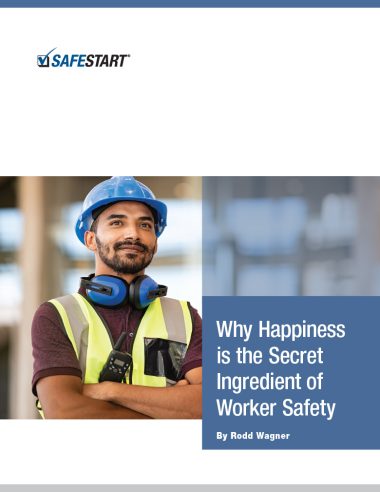By Rodd Wagner
Reading time is 20 minutes, or listen to the 30-minute audio version here.
Executive summary
- Safety is one of the most reliable outcomes of employee engagement, which is really worker happiness in disguise. Happy employees are better at keeping themselves and their colleagues out of harm’s way for reasons both conscious and subconscious. Six aspects serve as examples of the mechanisms that translate happiness into incidents prevented.
- The kinds of personalized approaches that make a person happy on the job also make it more likely an attentive manager will recognize one of his or her employees is having a bad—and therefore dangerous—day.
- Adequate levels of sleep are the foundation of both one’s outlook on life and the risk of making the kinds of errors that lead to accidents.
- All safety programs anticipate employees will speak up if they see something hazardous. The willingness to call out issues is synonymous with employees feeling they have a voice in facility decisions, which is an important component of job satisfaction.
- Human connections are one of the most important elements of a happy life. In an industrial environment, those bonds help members of a crew spot hazards for each other and keep themselves out of harm’s way.
- Compensation may not seem like a safety issue, but when workers unhappy with their pay find more money (and happiness) somewhere else, they leave behind a worksite that must work short-staffed or with a higher proportion of less experienced employees.
- Mindfulness—an awareness of one’s current situation—is considered central to happiness. Few leaders recognize how much mindfulness overlaps with the state of self-awareness and situational awareness. A person who has learned to navigate through their day experiencing it more completely, in a way that makes them happy, is also someone more likely to see and avoid hazards along the way.
Those who have watched enough Sesame Street will recall a jingle it uses to teach kids how to spot anomalies.
“One of these things is not like the others,” it goes. “One of these things just doesn’t belong.”
Red balloon. Red balloon. Blue balloon. Red balloon.
Apple. Mitten. Ice cream cone. Hamburger.
Flamingo. Airplane. Cow. Bee.
Spend enough time looking at how employee engagement drives performance and that Sesame Street earworm will return.
- Ensure workers are well managed and they will be less apt to resign, which they do 18 to 43 percent less often in top-quartile teams than they do in bottom-quartile workgroups.
- Engage employees and they will be less likely to call in sick, which they do 81 percent less often in top-quartile workgroups.
- Maintain morale and employees will prevent product defects, something they manage to reduce by 41 percent.
- Look after employees and they will sell more and produce more, which account for increases of 18 and 14 percent, respectively.
- Energize workers and they will manage to avoid 64 percent of the accidents suffered by their less-engaged counterparts.1
 That last statistic is not like the others. It doesn’t belong.
That last statistic is not like the others. It doesn’t belong.
That last statistic is not like the others. It doesn’t belong. Think of engagement as paddling a canoe. An engaged worker paddles forcefully in concert with the rest of the crew to move the team forward. A frustrated or demoralized worker doesn’t paddle as hard or jumps out and swims to shore.2 It’s in this slowing down or leaving that safety shows itself as the blue balloon, the mitten, or the cow of worker psychology.
- Underpaid? “I quit.”
- Being overworked? “I’m taking a ‘mental health day.’”
- Management doesn’t supply the right tools? “Defect rates are not my problem.”
- Seeing no future in the job? “Maybe I’ll lose a few fingers in the machinery today.”
That safety example doesn’t make sense. What sane person would get injured because he hates his job? All employees—whether energized or demoralized—want to avoid getting injured or killed on the job.
Before being exposed to the statistical connection between morale and safety, one might even argue it’s common sense that the most frustrated employees would be the safest because they would push themselves less, slow down, and better look out for themselves, just as they act out of selfinterest in absenteeism, productivity, and resignations. The reality is the type of counterintuitive truth discussed by Duncan J. Watts in his book Everything is Obvious* (*Once You Know the Answer).
“The first problem with common sense is that when trying to explain someone’s behavior, or to anticipate it, we focus on certain conscious motives and incentives that are most obviously relevant,” wrote Watts. “In doing so, however, we ignore a multitude of other possibly relevant factors, many of which operate below the level of consciousness. Thus, while it is true that people respond to incentives—somehow—this insight tells us little more than that ‘people have reasons for doing what they do.’ It doesn’t tell us either what they will do or what reasons they will have for doing it. Once we have observed their behavior, the explanation for it will seem obvious, but this ex-post obviousness is deeply misleading.”3
As is not obvious, the data show less engaged people are, in fact, worse at self-preservation. Safety is not only positively correlated with engagement, it is one of the strongest connections between attitude and outcome. Something different, something deeper, something perhaps partially subconscious, is happening to make workers with lower morale more hazardous to themselves and their colleagues. Cracking the code on that phenomenon reveals the secret ingredient of worker safety.
Why Engagement Studies Are Really About Happiness
One of the biggest reasons happiness is the secret ingredient in worker safety is that most of the research calls it something else. The analyses cited above connect better safety to higher “employee engagement,” not greater happiness. Shouldn’t engagement then be the goal? The answer to that question first requires an understanding of both concepts.
Engagement is a business term first coined in 1990 by Boston University professor William Kahn. It is, he wrote in the Academy of Management Journal, an employee’s dedication to the job, “the harnessing of organization members’ selves to their work roles,” how much they “employ and express themselves physically, cognitively and emotionally” on the job.4
Company leaders took to the terminology because it sounds productive, if not downright mechanical, like a gear working within a larger machine. Engagement is easier to justify as part of a business plan than happiness, especially when the majority of the research frames the results in terms of engagement. Happiness sounds less like a business imperative—too fuzzy or even frivolous.
For that reason, many engagement firms take a dim view of happiness. “The idea of trying to make people happy at work is terrible,” said Jim Clifton, the CEO of Gallup. A report from his organization compared employees to bears in Yellowstone National Park whose “natural instincts” are fouled up if they get a taste of human food. “Once the bears taste a peanut butter and jelly sandwich, they quit digging for roots and catching deer,” it said. “Don’t feed the bears.”5
But the working definition of happiness—the kind enshrined in the United States Declaration of Independence and the type that’s measured when SafeStart asks people about their happiness on the job—is a solidly productive emotion. It is “not about yellow smiley faces, self-esteem or even feelings,” wrote Jon Meacham, author of Thomas Jefferson: The Art of Power. “It was an ultimate good, worth seeking for its own sake. Given the Aristotelian insight that man is a social creature whose life finds meaning in his relation to other human beings, Jeffersonian eudaimonia— the Greek word for happiness—evokes virtue, good conduct and generous citizenship.”6
 In besmirching happiness on the job, some consultants and business leaders prefer to treat it as a condition wholly separate from and inferior to engagement. “Engagement isn’t about being happy. Happy people may or may not be engaged in the business,” asserted Jim Whitehurst, then CEO of Red Hat, in a 2016 Harvard Business Review article.7
In besmirching happiness on the job, some consultants and business leaders prefer to treat it as a condition wholly separate from and inferior to engagement. “Engagement isn’t about being happy. Happy people may or may not be engaged in the business,” asserted Jim Whitehurst, then CEO of Red Hat, in a 2016 Harvard Business Review article.7
“Someone can be happy at work, but not ‘engaged,’” wrote engagement author Kevin Kruse. “They might be happy because they are lazy and it’s a job with not much to do. They might be happy talking to all their work-friends and enjoying the free cafeteria food. They might be happy to have a free company car. They might just be a happy person. But just because they’re happy doesn’t mean they are working hard on behalf of the company. They can be happy and unproductive.”8
In fact, happiness and workplace engagement are neither separate from nor antagonistic to each other. They run in parallel. When, before signing on with SafeStart, I was the workplace research practice leader at BI Worldwide, we decided to empirically test the question of whether workers could be happy at work but not engaged. We asked people, “How happy are you at work?” with a 100-point slider and followed up that query with 36 more traditional engagement questions about aspects such as pay, work-life balance, meaning, teamwork, and professional growth. The correlation between job happiness and engagement was an exceptionally high 0.77.
“The overlap between those who are happy and those who are engaged is so large that there simply are no appreciable numbers of people who are happy at work and not engaged, or, conversely, engaged and not happy,” my colleague Amy Stern and I concluded. “In the vast majority of cases, engaged employees are happy, and happy employees are engaged.”9 Countering consultants’ assertions that happiness is a poor gauge, the BIW study found that happy employees are far more likely to feel obligated “to work as hard as I can for my organization,” to be innovative, and are much less likely to plan on resigning, among other outcomes.10
ISO 45003 recognizes the happiness-safety connection by focusing on the potential consequences of making employees unhappy, what it terms “psychosocial risks.” “It is important,” states the standards document, “that psychosocial risks are managed in a manner consistent with other (occupational health and safety) risks, through an OH&S management system, and integrated into the organization’s broader business processes.” Employee wellbeing, it asserts, depends on the “fulfilment of the physical, mental, social and cognitive needs and expectations of a worker related to their work.”11
Correlations between engagement and “satisfaction,” a less intense form of job happiness, run as high as 0.91 even in Gallup’s own analyses, making them “virtually identical.” In fact, some social scientists question whether the concept of employee engagement adds anything to the mix. Given it’s a relatively new label put on ages-old human phenomena, it may be nothing more than “old wine in new bottles.”12
There is no standard or universally accepted definition of employee engagement. Kahn’s reference to emotional commitment and the level of physical and mental work fit the subsequent research. In its simplest form, engagement is the intensity employees deliver at work in reciprocation for the investments their companies make in their experience at work.
The logic is straightforward: If “engaged” employees are far safer, and engagement and happiness are “virtually identical,” happy employees are safer employees. In SafeStart’s surveys for clients, the connection is even clearer: The happier an employee is at work, the less he or she feels at risk of an accident.13
Putting Happiness at the Center of the Company Strategy
The strong statistical connection between happiness and safety is sufficiently compelling to inspire a company’s guiding philosophy. There is nothing wrong—and quite a bit right—with senior leaders saying, “We aim to make our employees happy, both because it’s the right thing to do and it improves our performance.” It’s an essential overarching intention, a worthy gauge against which tactics can be judged.
But by itself, it runs the risk of being nebulous. “Make them happy and they’ll be safe” or “Improve morale and accidents will go down”—although true—are not enough. Translating that solid philosophy into a low-incident reality requires an understanding of at least some of the likely mechanisms behind the phenomenon. It requires an operational strategy built on that psychological wiring. Leaders and frontline managers need to understand how their decisions and actions affect their teams and how they translate into lower risk.
 I am not necessarily arguing for a direct cause-and-effect relationship, that happiness per se makes people safer, although it probably does. What the data strongly indicate is that many of the conditions that make people happy also make them safe. Some of those effects are conscious decisions, such as complying with safety protocols. Others, such as intense situational awareness, may be less deliberate, less obvious, making the safety connection “not like the others.”
I am not necessarily arguing for a direct cause-and-effect relationship, that happiness per se makes people safer, although it probably does. What the data strongly indicate is that many of the conditions that make people happy also make them safe. Some of those effects are conscious decisions, such as complying with safety protocols. Others, such as intense situational awareness, may be less deliberate, less obvious, making the safety connection “not like the others.”
From a practical perspective, it doesn’t matter whether the pattern is linear (certain job conditions create happiness, which reduces accidents) or the result of dual pathways (certain job conditions simultaneously create happiness and better safety). In either case, an enlightened leader will put his or her employees’ psychological wellbeing at the center of the strategic plan.
Below are six aspects of an organization’s culture where the conditions that make a person happy on and off the job have a demonstrated effect on the number and severity of accidents. They are not the only mechanisms, but emerge as some of the most compelling and important. In combination, they are more than enough to make the case of making worker happiness the centerpiece of a safety strategy.
Individualization
Patterns in employee engagement are most easily discerned by analyzing group data. This unavoidably creates generalizations—connections that are true for many in the group, but not true for all. I summarized the issue in my most recent book, Widgets:
“Employee engagement is an individual phenomenon. Every person’s motivations, abilities, and goals are unique. Each person’s reasons for needing or wanting to work differ. Everything needs to be adapted to the circumstances and personality of the individual worker. The most important imperative to prevent employees from being treated like widgets is to ensure each is led and managed in a way that fits his or her personality. That can happen only if someone takes the time to really decipher that employee, to get inside his or her head.”14
“Getting inside someone’s head” is crucial to their happiness. Statements such as “My manager understands me,” “My manager makes decisions with my best interest in mind,” and “My manager divides work among our team according to employees’ abilities” all correlate with people’s happiness on the job.15 Nearly every study of engagement and job happiness has demonstrated the key role played by frontline managers, those in authority in the best position to adapt general company programs into personalized approaches.
Individualization is also crucial to worker safety. The recognition in recent years that women’s personal protective equipment can’t simply be “one size smaller” is a case in point. “Besides being uncomfortable and sometimes even clownish-looking, ill-fitting PPE is a safety hazard,” concluded a 2020 column in Safety+Health. “The oversized safety shirts and jackets issued to women can be cumbersome, especially with excess fabric at the sleeves that can get caught in machinery. The fit is often too blocky and clumsy, and can interfere with the use of tools and operation of equipment.”16
An attentive manager also recognizes when a worker seems tired or distracted, how fast or through what methods she or he learns best, what she or he needs to watch out for during the coming shift, and how to match tasks to abilities. All these types of individualization make a person happier. They also make a person safer.
Sleep
There are few areas that so clearly affect happiness as sleep. “Poor sleep predicted a consistent pattern of life dissatisfaction,” concluded one study of identical twins in Finland.17 “Both positive affect and eudaimonic wellbeing are directly associated with good sleep,” determined another.18 “Those who sleep well are more satisfied with life,” found yet another.19
“No matter how active and vigorous and successful we are during our wakeful hours, if we don’t obtain an adequate amount of sleep, we’ll suffer in terms of our moods, energy, alertness, longevity, and health,” wrote Dr. Sonja Lyubomirsky in her book The How of Happiness.20
SafeStart’s client studies show a similar pattern. Those who agree or strongly agree “Work-life balance here allows me to get enough sleep” report that their time in bed between shifts is typically seven to seven-and-a-half hours. Those who disagree or strongly disagree are getting six hours or less. And their sleep levels correlate strongly with their agreement with the statement, “I’m happy with my job.”
Running parallel are a host of studies that indicate the risk of accidents increases substantially when a person is low on sleep. One of the best studies on that increased risk was conducted in 2016 by the AAA Foundation for Traffic Safety. If the baseline accident risk after a proper seven-plus hours of sleep is set to 1.0, the accident risk rises to 1.3 (30 percent greater) between six and seven hours, to 1.9 (90 percent greater) between five and six hours, to 4.3 (330 percent greater) between four and five hours, and to 11.5 (1,050 percent higher) below four hours.21
Adequate sleep makes people happier. It also makes them much safer.
A Real Voice
One of the building blocks of engagement and job happiness is what’s called “employee voice” in the research literature. It is the degree to which a worker feels his or her perspective is incorporated into how the organization is managed. It’s measured on nearly every employee survey by a statement along the lines of how much people feel their “opinions count.” SafeStart asks a more pointed question about whether “the company is always asking employees for their input on how to improve safety.”
One study concluded, consistent with the broader body of research, that “employees who perceive themselves as speaking up with opinions and suggestions are more likely to be engaged with their work. Moreover, the results show that trust in management and, to a lesser extent, the employee–frontline management relationship are important in achieving this outcome.”22
The link between voice and safety is both logical and empirical. A worker who feels the company doesn’t care about his views is likely to hold his tongue more often, even when seeing a potentially hazardous situation such as a loose railing, spill, or machine needing repair. Conversely, the sense of responsibility or psychological “ownership” for which leaders so often hope is the natural consequence of a workforce that believes their perspectives are important to decision-makers and frontline managers.
Accident-prone teams focus more on internal processes, while the safer teams emphasize “human relations,” concluded a 2012 study of workers in high-risk workplaces in Australia. “A lack of perceived control on the part of employees is known to adversely affect morale and limit the desire for learning and development. The overall effect may be to encourage the development of a passive orientation to safety, in which responsibility for safety is seen as part of someone else’s role, and adaptivity and proactivity are not encouraged.”23 This is the reason SafeStart asks its clients’ employees whether “My manager explains the reasons behind our safety procedures rather than simply enforcing the rules.” Those who answer positively are less likely to say they feel at risk on the job.
Analyses of SafeStart client surveys show high correlations between how much employees see their leadership team asking for their input, their happiness on the job, and their response to the statement, “I feel comfortable reporting unsafe situations, near misses, or close calls without fear of retaliation.”
Believing one has a real voice in how work is done makes a worker happier. It also makes his or her coworkers safer.
Collaboration
Isolation makes people miserable. One study concluded it poses dangers as serious as cigarette smoking, high blood pressure, high cholesterol, obesity, or lack of exercise.24 Humans are naturally social creatures and need partnerships and friendships on the job to be happy there.
 As Dr. Gale Muller and I observed in our book, Power of 2, “The more good partnerships you have in your life, the more likely you are to say that you experienced the feeling of enjoyment much of the day yesterday, that you recently learned something interesting, and that you’ve been doing a lot of smiling and laughing — all key measures of your happiness. Even having one strong partnership markedly increases your wellbeing over those who have none.”25
As Dr. Gale Muller and I observed in our book, Power of 2, “The more good partnerships you have in your life, the more likely you are to say that you experienced the feeling of enjoyment much of the day yesterday, that you recently learned something interesting, and that you’ve been doing a lot of smiling and laughing — all key measures of your happiness. Even having one strong partnership markedly increases your wellbeing over those who have none.”25
Safety is often a team sport, whether it’s one person steadying the ladder another is climbing, two pilots talking through what they see on a plane’s instruments, or one electrician labeling his work so another who follows knows what’s been done. Simple failures to coordinate or to notice something, which may mean nothing in an office environment, can be fatal in a hazardous one.
The safety research proves the old saying that two heads are better than one. Strong collaboration saves fingers, eyesight, and lives. A 2011 metaanalysis of 203 separate studies totaling 186,440 employees found that a “supportive” work environment—trustworthy leadership, autonomy, good coworkers—is “the most consistent job resource in terms of explaining variance in burnout, engagement, and safety outcomes.” Burnout, the analysts concluded, is “significantly related to accidents and injuries.”26
Higher levels of collaboration make employees happy. That teamwork also arms them to fend off accidents.
Pay and Benefits
Compensation may not seem to have a connection to safety for the same reason mentioned earlier that it’s illogical for less happy people to get hurt more often. Why would a person paid less be more likely to get hurt?
Compensation’s effect on accidents is further upstream than many other elements. In the current worker shortage, SafeStart often sees client tenure graphs with a high concentration of employees on the left side, those who have been with the company less than a year. Just as demand for many products surges, the so-called “Great Resignation” drew away large numbers of many companies’ experienced workers elsewhere for higher pay and better benefits. They were unhappy with the bargain, and they left.
In their wake, one of two things happened: Either those people were replaced with new hires who were unfamiliar with the processes, equipment, and hazards; or their former colleagues were required to pick up extra hours or work short-handed. Both situations are inherently more dangerous than if the turnover had not occurred. One of the most common hazards revealed by SafeStart’s worker surveys are high proportions agreeing “People here sometimes feel pressure to keep working when they lack the right knowledge or sufficient experience.” The more strongly they agree, the more they fear a future accident.
Compensation will never appear as a root cause of an accident. The proximate issues such as insufficient training, fatigue, or poor maintenance will appear on the reports. It is nonetheless true that many incidents would not occur if companies paid their workers enough to keep them happy, keep them and their “institutional knowledge” inside the plant, and thereby prevent many accidents.
Mindfulness
The speed of business today is disorienting. The pace of production, texts, alerts, and the hundreds of distractions on a smartphone can make it difficult to maintain a normal stream of consciousness. The unending string of distractions can be mentally fatiguing and ultimately make a person unhappy on the job.
It’s not surprising, therefore, that many company wellbeing programs include options to improve one’s mindfulness. Highly mindful people “are models of flourishing and positive mental health,” wrote Dr. Lyubomirsky. Relative to the average person, they are more likely to be happy, optimistic, self-confident, and satisfied with their lives and less likely to be depressed, angry, anxious, hostile, self-conscious, impulsive, or neurotic.”27 Employees who fit the former description would logically outperform those in the latter category in retention, customer focus, productivity, and creativity.
But there is no situation where mindfulness—Dr. Lyubomirsky defines it as “attentive to the here and now and keenly aware of their surroundings” —is more important than in a hazardous environment. This, in fact, lies at the heart of SafeStart’s training of frontline workers in situational awareness and self-awareness. Consciousness of one’s mental state, especially those states that can lead to critical errors in the presence of high energy, can literally mean the difference between life and death.
A mindful person is happier. A mindful person is also safer.
The Power of Reciprocity
The reason happiness and engagement correlate so highly is because they are corresponding sides of a solid social contract. The enterprise wants engagement (evidenced by enthusiasm for the job, teamwork, dedication to the enterprise mission, customer focus, care for company resources, for example); the employee wants happiness (in the form of salary and bonuses, health care, adequate time off, credentials, and personalized attention, among other benefits).
The ultimate reason to focus on happiness rather than engagement is because it better creates a two-sided bargain, unleashing the power of human reciprocity. Employees who most forcefully agree with the statement, “My employer is trying to make me happy” are most inclined to look out for that employer’s interests.28
 An organization that focuses too much on its own goals (engagement and the attendant business outcomes) risks alienating its workforce. An enterprise that methodically determines what its employees want from their time there (sometimes called the “employee value proposition” or “employee experience”) and delivers on those expectations creates the motivation that fuels those higher levels of performance.
An organization that focuses too much on its own goals (engagement and the attendant business outcomes) risks alienating its workforce. An enterprise that methodically determines what its employees want from their time there (sometimes called the “employee value proposition” or “employee experience”) and delivers on those expectations creates the motivation that fuels those higher levels of performance.
In a 2012 CNN interview, safety leadership legend and former Alcoa CEO Paul O’Neill called it “discretionary energy” delivered when employees are “treated with dignity and respect every day… A down payment on that is nobody ever gets hurt here, because we care about our own commitment to our safety, and we care about the people we work with. And it swells up into everything you do, so it creates the sense of pride about the organization you’re involved in.”29
Happiness creates far more than these six pathways to higher safety outlined here. It sparks innovation, making manufacturing processes simpler and safer. It creates greater trust in leaders, greater belief that safety really does come before production, and therefore greater willingness to hit stop before a serious break. It feeds the willingness to comply with safety protocols rather than disregard what the company has requested. And overall, it leads to people, who of course don’t want to get hurt, through dozens of difficult-to-document causal connections, being better at actually avoiding the catastrophic.
Because of its unique and sometimes counterintuitive power to keep people safe, happiness is, indeed, not like the other effects of high morale. But as the central strategy for motivating a safe workforce, it most definitely belongs.
Rodd is a New York Times bestselling author and Forbes columnist. His books, columns, and speeches focus on human nature at work. Rodd leads SafeStart’s Assessment & Diagnostics practice. He is a former principal of Gallup and Salt Lake Tribune editor and reporter.

Get the PDF version
You can download a printable PDF of the article using the button below.
References
1. Harter, James K., et. al. (2020). The Relationship Between Engagement at Work and Organizational Outcomes 2020: Q12 Meta-Analysis: 10th Edition. Gallup white paper.
2. Many engagement consultants assert that “disengaged” employees will even paddle backwards. One consultant labels frustrated employees “brats,” “under-achievers,” “delinquents,” “drifters,” “saboteurs,” “cynics,” and “martyrs.” One advisory firm maintains demoralized workers “are more or less out to damage their company.” Another consultancy labels worn-down employees as traitors Brutus and Benedict Arnold. There is little evidence of such malice. Such namecalling is nothing more than unfairly blaming the victims of poor management for normal responses to neglect and excessive pressure. See Wagner, Rodd (December 8, 2015). The Beatings Continue and Morale Fails to Improve. Forbes.com.
3. Watts, Duncan. Everything is Obvious* (*Once You Know the Answer) (New York: Crown Business, 2011).
4. Kahn, William A. “Psychological Conditions of Personal Engagement and Disengagement at Work.” The Academy of Management Journal, Volume 33, Issue 4, Academy of Management, 1990, pp. 692–724, https://doi.org/10.2307/256287.
5. Crowley, Mark C. “Why Being Engaged at Work Isn’t as Simple as ‘Being Happy.’” FastCompany.com September 30, 2014. http://www. fastcompany.com/3036399/the-future-of-work/why-being-engagedat- work-isnt-as-simple-as-being-happy.
6. Meacham, Jon. “Free to Be Happy.” Time; June 27, 2013. https:// nation.time.com/2013/06/27/free-to-be-happy/.
7. Whitehurst, Jim. “How to Build a Passionate Company.” Harvard Business Review; February 15, 2016. https://hbr.org/2016/02/how-tobuild- a-passionate-company.
8. Kruse, Kevin. “The Difference Between Happiness and Engagement at Work.” Forbes.com; December 21, 2012. https://www.forbes.com/ sites/kevinkruse/2012/12/21/happy-at-work
9. Wagner, Rodd, and Amy Stern. (2016). #WorkHappier: Employee Motivation in the United States. BI Worldwide white paper. https://www. biworldwide.com/research-materials/blog/workhappier-whitepaper/.
10. Wagner and Stern.
11. ISO 45003: Occupational health and safety management — Psychological health and safety at work—Guidelines for managing psychosocial risks. International Organization for Standardization, 2021. https://www.iso.org/standard/64283.html
12. Briner, Rob. (2014). What is employee engagement and does it matter?: An evidence-based approach. The Future of Engagement: Thought Piece Collection. 10.13140/2.1.3748.2887.
13. A statistically significant and meaningful correlation between job happiness and perceived on-the-job safety emerges each time SafeStart conducts its Human Factors Assessment at a client organization. Those correlations average -0.28 between “I am happy with my job” and “I am concerned I will have an accident on the job.” They average -0.39 between job happiness and the statement “For safety reasons, I wouldn’t want a friend or relative to work here.”
14. Wagner, Rodd. Widgets: The 12 New Rules for Managing Your Employees As If They’re Real People (New York: McGraw-Hill, 2015).
15. Those three statements were part of the research behind the book Widgets. They are the copyrighted intellectual property of BI Worldwide and should not be used in a survey without BIW’s permission.
16. Fisher, Randal. The need for unique women’s PPE: Is the “one size smaller” rule for women’s personal protective equipment adequate? Safety+Health, April 26, 2020. https://www.safetyandhealthmagazine. com/articles/19752-the-need-for-unique-womens-ppe
17. Paunio, Tiina, et. al. Longitudinal Study on Poor Sleep and Life Dissatisfaction in a Nationwide Cohort of Twins, American Journal of Epidemiology, Volume 169, Issue 2, January 15, 2009, Pages 206–213, https://doi.org/10.1093/aje/kwn305
18. Steptoe A, O’Donnell K, Marmot M, Wardle J. Positive affect, psychological well-being, and good sleep. Journal of Psychosomatic Research, Volume 64, Issue 4, April 2008, Pages 409-415. doi: 10.1016/j.jpsychores.2007.11.008. PMID: 18374740.
19. Ji-eun Shin and Jung Ki Kim. How a Good Sleep Predicts Life Satisfaction: The Role of Zero-Sum Beliefs About Happiness. Frontiers in Psychology 28 August 2018. https://doi.org/10.3389/fpsyg.2018.01589
20. Lyubomirsky, Sonja. The How of Happiness: A New Approach to Getting the Life You Want (New York: Penguin Group, 2007).
21. AAA Foundation for Traffic Safety. “Acute Sleep Deprivation and Risk of Motor Vehicle Crash Involvement.” (Washington, D.C.: 2016)ht tps: //aaafoundation.org/wp-content /uploads/2017/12/ AcuteSleepDeprivationCrashRisk.pdf
22. Chris Rees, Kerstin Alfes & Mark Gatenby (2013) Employee voice and engagement: connections and consequences, The International Journal of Human Resource Management, Volume 24, Issue 14, Pages 2780-2798 DOI: 10.1080/09585192.2013.763843
23. Colley, Sarah K., et. al. An examination of the relationship amongst profiles of perceived organizational values, safety climate and safety outcomes. Safety Science, Volume 51, Issue 1, January 2013, Pages 69-76.
24. House, James S., Karl R. Landis, and Debra Umberson. “Social Relationships and Health.” Science 241.4865, 1988, Pages 540-545. 25. Wagner, Rodd, and Gale Muller, Ph.D. Power of 2: How to Make the Most of Your Partnerships at Work and in Life (New York; Gallup Press, 2009).
26. Nahrgang, Jennifer D., Frederick P. Morgeson, and David A. Hofmann. Safety at work: a meta-analytic investigation of the link between job demands, job resources, burnout, engagement, and safety outcomes. Journal of Applied Psychology. January 2011, Volume 96, Issue 1, Pages 71-94. doi: 10.1037/a0021484 AcuteSleepDeprivationCrashRisk.pdf
27. Lyubomirsky.
28. Wagner and Stern.
29. Zakaria, Fareed. “Fareed Zakaria GPS.” CNN, December 23, 2012. http://www.cnn.com/TRANSCRIPTS/1212/23/fzgps.02.html

